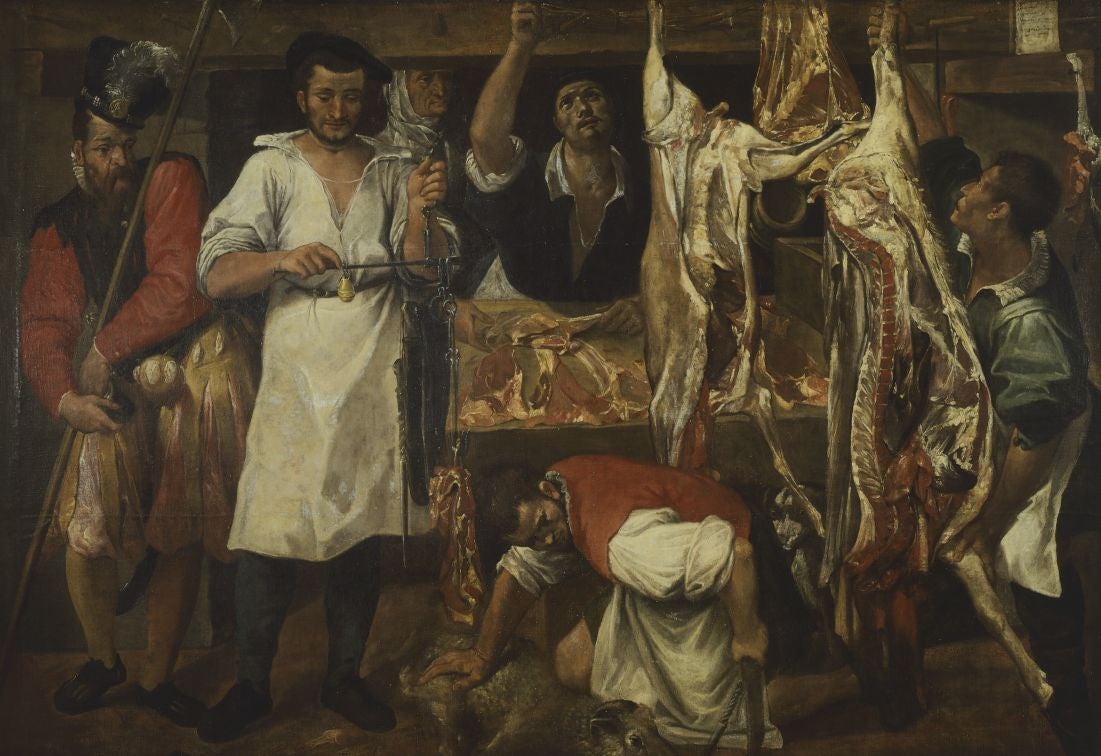The Butcher’s Shop, by Annibale Carracci
(c1583) 185cm x 266 cm Christ Church Collection, Oxford

How respectable has butchery been as a subject for painting? Not very. In many Lombard and Netherlandish paintings, the butcher’s shop (or, more likely, market stall) is a place of near disorder, where unsavoury examples of low life lurk and scheme in the close vicinity of butchered flesh, bloodied aprons and buckets of gut-wrenching intestinal slop.
Somewhat in the same vein, we might also consider the case of the Bolognese painter Bartolomeo Passarotti, who in 1578 created a great and savage scene of a butcher’s stall which verges on low-life caricature. The two butchers seem to be taunting us as they flaunt their cuts of meat. One of them, grinning, prises open the tusks of a boar as if to frighten the onlooker.
Quite different in mood and manner is Annibale Carracci’s The Butcher’s Shop, which was painted just five years after Passarotti’s part-comic scene. Carracci, also Bolognese, knew a lot about butchery – his uncles were butchers. He knew a lot about religion, too.
In fact, this low-lit scene seems to be more of an altarpiece than a familiar glimpse of every-day life. See, for example, how differently Carracci has depicted the several butchers and their customer. In the Passarotti, the butchers grin, snarl and smirk – one of them is lacking a front tooth – at the onlooker, as if they are trying to tempt us into a scene of mayhem.
Carracci’s butchers, on the other hand, are unusually self-absorbed. Not one of them is looking at us. They are all gravely intent upon the task in hand. Much less attractive than any of these butchers on display here is the customer with the plumed hat who seems to be creeping in from the left.
He ranks middling-to-high on the scale of depictions of roguishness, we feel, as we watch him awkwardly fumbling for his coins. The butchers, by comparison, are not behaving in an awkward, disorderly or provocative fashion at all. They seem to be the very models of calmness and decorum, most unbutcherly, in fact.
Most grave of all is the butcher who is positioned farthest away from us. He looks upward, right arm raised. If this painted face were to be removed from here and inserted into a crucifixion scene, we feel that it would be perfectly at home there. That gesture of reaching up towards we know not quite what looks almost pious.
It seems to possess a kind of ghostly symbolic force – as does the weighing of the meat by the butcher who stands to the left of the customer. This could be a man weighing human souls in the balance. Most tenderly provocative of all is the depiction of the butcher who kneels in front of us, right at the front of the picture plane.
He is about to butcher a lamb – he grips his cleaver in his left hand. Meanwhile, his right hand presses down on the lamb’s rump with a kind of gentle firmness, as if to suggest that, regrettable though it may be, there is no alternative to this sacrifice.
There is nothing brazen or perfunctory about his look, nothing which suggests that this is a common-or-garden, everyday matter for butchers the world over. His downcast gaze rather suggests sadness, some undeclared burden of responsibility. The atmosphere that surrounds this coming killing – more sacrifice than random killing, we feel – is unusually solemn, as if this is more the Paschal Lamb that is about to be sacrificed than any old lamb from the field.
What is more, there is something rather curious about the way in which much of the butchered flesh in shown in this painting. It lacks fleshiness; it lacks the texture, the mess, the blood. Look at that row of hanging carcasses, and how they are being carefully shifted along what might be a rail. They have a kind of sheen about them – almost as if they were glittering vestments. And this entire atmosphere of deliberate, almost reverentially done, work is enhanced by the low, crepuscular lighting of the painting, by the fact that everything here seems to be proceeding slowly and almost ritualistically.
Clearly, a butcher’s stall is not to be sniffed at.
About the artist: Annibale Carracci (1560-1609)
The Bolognese painter Annibale Carracci made works of great variety, from classical landscapes to mythological scenes. He, his brother and cousin founded an academy in Bologna to teach painting, and to revive the traditions of classical art. Among his greatest achievements were his decorations for the Palazzo Farnese in Rome, which included delightful classical landscapes and a series of frescoes that were compared with the work of Raphael and Michelangelo.
Join our commenting forum
Join thought-provoking conversations, follow other Independent readers and see their replies
Comments
Bookmark popover
Removed from bookmarks